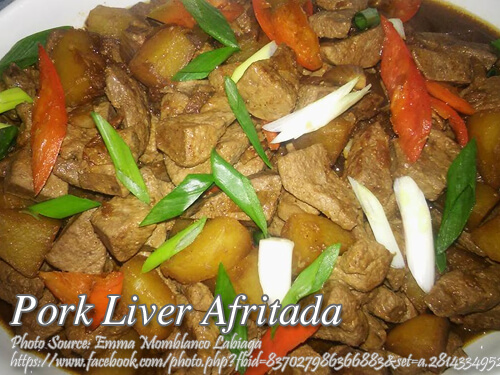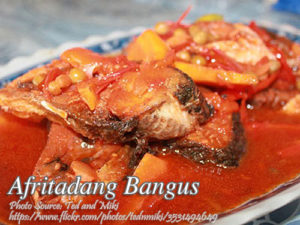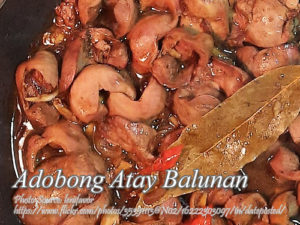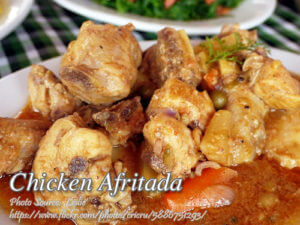Pork liver afritada is a simple pork liver dish which is very similar to chicken or pork afritada. Instead of using chicken or pork meat, pork liver is used. Cooking liver doesn’t require a long time to tenderize because the longer the cooking time, the tougher it will become. As much as possible, it should only be half cooked but it won’t kill the parasites or organisms which might cause diseases. The only option is to cook it thoroughly just like in the recipe instructions below or you can marinate it first with a little vinegar before cooking.
Savor the Delectable Afritadang Atay ng Baboy
A mouthwatering pork liver afritada is a delightful fusion of rich flavors and succulent textures. This Filipino delicacy showcases tender pork liver as the star ingredient, enhanced by a harmonious blend of vegetables and aromatic spices. With roots in the classic chicken or pork afritada, this dish offers a unique culinary experience. Let’s embark on a journey to unravel the secrets of this tempting fare, guiding you through the preparation process to achieve perfection.
Unraveling the History of Afritada
The word “afritada” has Spanish roots, stemming from “fritada,” meaning fried. This tasty dish arose during the colonial period when Spanish settlers influenced Filipino cuisine. While initially using simple pork or chicken, cooks later crafted a distinct version with liver’s rich flavor. Combining indigenous and Spanish elements, afritada exemplifies the cultural blend shaping the Philippines’ culinary heritage. Its harmonious blend of robust yet nuanced flavors has made it a cherished national dish.
Crafting Tender, Flavorful Pork Liver Dishes
Preparing pork liver requires careful attention to cooking times. Unlike tougher cuts of meat, liver doesn’t demand extensive cooking; overcooking can leave it unappetizingly chewy. However, safe consumption means ensuring the liver reaches an adequate internal temperature to eliminate any potential hazards from undercooking. A simple technique to maximize flavor while prioritizing food safety: marinate the liver in vinegar before cooking. This process helps mellow any strong or unpleasant flavors.
Mastering the Iconic Filipino Pork Liver Afritada
Awakening the Aromatics
Commence your culinary journey by warming oil over gentle heat, then introducing the onions and garlic to the pan. Allow these fragrant companions to soften and release their alluring scents, laying the groundwork for a flavor-rich adventure.
Elevating the Pork Liver’s Presence
Once the aromatics have achieved their translucent transformation, it’s time to welcome the star ingredient – the pork liver. Briefly sauté these jewels, sealing in their precious juices and infusing them with the aromatic essence.
Harmonizing with Savory Accents
Artfully drizzle a touch of patis (fish sauce) into the simmering medley, allowing it to mingle briefly and concentrate its umami depth. In harmony, fold in carrots, potatoes, and tomato sauce, gently coaxing the flavors to meld seamlessly.
Simmering to Perfection
Allow the ingredients to simmer gently. Stir occasionally to prevent sticking, ensuring even cooking. This permits flavors to blend deliciously.
Finishing Touches
As vegetables start softening, add green peas or chickpeas, bell peppers, water, salt, and pepper. Simmer further until all components become tender and absorb the sauce’s savory essence.
Thickening the Sauce
To achieve the desired texture, introduce a cornstarch slurry into the simmering mixture. This thickening agent unifies flavors, creating a luscious, velvety sauce.
Serving and Enjoying
Once the sauce reaches the perfect consistency, remove the pan from heat. Serve the afritada piping hot, accompanied by steamed rice or crusty bread. Garnish with fresh herbs, adding a vibrant pop of color and an extra burst of flavor. Savor each spoonful’s rich, hearty goodness – Afritadang atay ng baboy truly embodies Filipino culinary heritage.
A Final Note
Pork liver afritada is undeniably delectable, but it’s crucial to handle and cook liver carefully, ensuring both taste and safety. By following proper cooking techniques and hygiene practices, you can indulge in this culinary delight with confidence. Every bite celebrates flavor and tradition.
Afritadang Atay ng Baboy (Pork Liver Afritada)
Ingredients
- 1/2 kilo pork liver cut into bite size pieces
- 3 pc medium size potatoes peeled and quartered
- 2 pcs medium size carrots peeled and cut into wedges
- 1/2 cup green peas or chickpeas
- 1 pc red bell pepper sliced into strips
- 3 cloves garlic crushed
- 1 pc large onion sliced
- 1/2 cup tomato sauce
- 1 to 2 Tbsp. patis fish sauce
- 3/4 cup water
- 1 tsp. cornstarch dissolved in 1 Tbsp. water
- salt and pepper
Instructions
How to cook Afritadang Atay ng Baboy:
- Heat oil in a pan and saute onion and garlic until onions are soft. Next, add the pork liver and saute for a minute.
- Then add the patis and stir cook until the patis has slightly evaporated then add the carrots, potatoes, tomato sauce. Simmer for 5 minutes while stirring once in a while.
- Then add the green peas or chick peas, bell peppers, water, salt and pepper. Simmer for another 3 minutes or until cooked.
- Last but not the least, add the cornstarch slurry (dissolved cornstarch in water) and simmer for about a minute or more until the sauce is thickened. Serve hot.
Notes
Cooking Tips:
Selecting Fresh Pork Liver
When purchasing pork liver for afritada, choose liver that is firm and has a deep red color. Avoid liver with any greenish or brown spots, as this may indicate spoilage. Additionally, opt for liver that has a slight sheen, indicating freshness.Preparing the Liver
Before cooking, it's essential to clean the pork liver thoroughly. Rinse the liver under cold water and remove any visible veins or connective tissue. For added flavor, marinate the liver in vinegar for about 30 minutes before cooking to reduce any strong odors.Cooking the Liver Just Right
To achieve the perfect texture, cook the liver just until it is no longer pink on the inside. Overcooking can result in tough and rubbery liver. Remember, liver continues to cook slightly after removing it from the heat, so a slightly pink center is okay as long as it reaches a safe internal temperature of 160°F (71°C).





